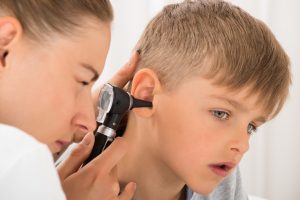Media Release
5 March 2020
Researchers from the Telethon Kids Institute have identified the main bacteria responsible for recurrent ear infections and repeat ear surgeries in children.
Latest research from the Institute’s Wesfarmers Centre of Vaccines and Infectious Diseases has found that children who had Haemophilus influenzae (NTHi) bacteria present in their ear during grommet surgery were three times more likely have re-occurring infections and require repeat procedures to address their ear health issues.
This new finding, published in the Pediatric Infectious Disease Journal, builds upon previous research, which showed that the same bacteria was the main cause of middle ear infections.
Affecting 650,000 Australian children every year, these infections (also known as otitis media) can lead to multiple surgeries and many years of antibiotic use, hearing loss and ear pain.
Dr Lea-Ann Kirkham, Co-Director of the Wesfarmers Centre of Vaccines and Infectious Diseases and Team Lead of the Bacterial Respiratory Infectious Disease Group, says the results are an important step towards eliminating ear infections in young children.
“Initial results from our study in 2007-09 confirmed NTHi was the main bacterial cause of ear infections in Western Australia, and eight years later we have now demonstrated that NTHi is also the key predictor for repeat surgeries – this is pivotal in guiding our research strategies going forward,” Dr Kirkham continues.
“We can now put all of our focus onto a two-pronged approach against NTHi – preventing the bacteria from growing in the first place and developing new treatment methods that will ensure any bacteria living in the ear is killed in the first instance and does not cause further problems.”
“The next phase of our research is already underway, with a nasal spray designed to prevent NTHi bacteria from causing ear infections in development. The nasal spray contains a ‘friendly’ species of bacteria found inside the nose and works like a probiotic, guarding the ear from infection.”
The NTHi bacteria is notoriously difficult to treat when present in the ear – living in a sticky glue that protects the bacteria from antibiotics and blocks the ear canal.
Dr Kirkham’s research team are also working with doctors at Perth Children’s Hospital to trial an innovative method using medication commonly used to treat cystic fibrosis to ‘break down’ the sticky glue in the ear and allow antibiotics to kill the bacteria, with pilot studies showing very promising results.
Dr Kirkham says that reducing the burden of ear infections in children cannot be underestimated – otitis media is the main reason for children to be taken to the GP and given antibiotics, and a major reason why young Australian children have surgery.
“Children will also no longer have to deal with the long-term consequences of sustained hearing loss from repeat otitis media. When kids can’t hear they can’t learn – leading to issues surrounding education, speech, behaviour and social relationships, so preventing the leading cause of otitis media will give kids the best developmental start to life,” said Dr Kirkham.
For more information about ear health and bacteria respiratory disease research by the Wesfarmers Centre of Vaccines and Infectious Diseases, please visit: vaccine.telethonkids.org.au
Source: Scimex








